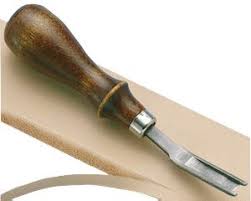You want thick leather, say 3mm-4mm. You'll find it stiff, but when working with it, it really helps to soak in warm water for 30 seconds, it greatly softens it up to the point the leather feels like thin rubber, makes it really easy to work with for folding, wet forming around a knife (you can form it around the handle so the knife clicks into place), and helps the dye to soak in evenly too.
Adjustable groover: Drag it along the edge of where you want to sew, it cuts a small thin groove parallel to the edge, sets the line to follow for sewing, but also lets the top of the stitches sit flush with the top of the leather surface, greatly reduces the risk of the threads becoming damaged from coming into contact with sharp objects, like rocks, etc.

Overstitch wheel: Lays out where the holes will be. I tend to use the 5 holes per inch mostly, but also have 6 and 7 hpi too. Can also use it after sewing to press the threads/lockstitches into the holes (hence the name of overstitch).

Awl: Use to punch your holes, also helps to open holes up bigger as you sew.

Edging tool: Use to cut a rounded edge on your leather, reduces fraying and looks cleaner when finished.

Avoid using the sewing awl, it makes messy stitches, best to go for a simple needle and thread. Use pliers to help get the needle through the holes, and use waxed thread (it locks with friction).

Dyes, water based seem to be the easiest to work with, you can mix colours together, say red and dark brown to get a lighter medium brown, and can also thin the dye with water. Really handy. Is what I did on this sheath Christmas day:
